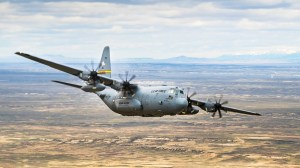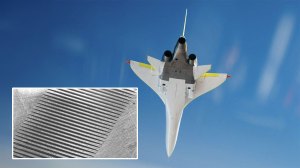Boom’s recent supersonic tests included an experimental sharkskin-like material that makes the aircraft smoother and therefore more efficient. Developed by Micro Tau in Australia, the riblet-skinned material reduces drag, fuel consumption, and carbon emissions.
Last fall, Boom applied patches of the material during testing of its experimental XB-1 to its underbelly. The material is a film with microscopic grooves or riblets on the surface. It is designed to mimic a shark’s skin by reducing friction and smoothing out turbulent airflow. A shark’s skin is covered in microscopic grooves called dermal denticals that allow it to swim more efficiently, using less energy.
The gray underbelly is the section with the sharkskin material. The inset shows its microscopic ridges.
The first XB-1 flights were initially subsonic flights to test the material’s adhesive qualities, and its later supersonic tests also left the Micro Tau material unscathed. Boom tested the material for the Defense Innovation Unit (DIU), the Department of Defense’s organization for accelerating the adoption of commercial and dual-use technology, and the Air Force Operational Energy Office, dedicated to increasing operational efficiency of military aircraft.
Typically, an aircraft design deals with drag by increasing engine thrust, which necessitates more fuel. That in turn leads to a heavier aircraft which, by definition, requires larger engines. Reducing drag by even a small percentage reduces fuel consumption (and therefore emissions) while enhancing operational efficiency.
The sharkskin-like material could be used by the U.S. Air Force on legacy aircraft that include the C-17 Globemaster III, C-130 Hercules cargo transport and the KC-135 Stratotanker aerial refueling airplane. The three large aircraft, which carry large amounts of cargo or fuel, require unusual amounts of fuel.

The behemoth C-130 Hercules military cargo transport plane will also get the sharkskin-like material to enhance its operational efficiency.
US Air Force
Delta Airlines is also testing the Micro Tau skin on its Boeing 767 fleet. The shark skin can be applied to an aircraft’s fuselage, wings, and tail, and could improve efficiency up to 4 percent, according to Micro Tau estimates. “From a big-picture perspective, our Riblet Package product can potentially save the aviation industry up to $10 billion in fuel annually,” said MicroTau Founder and CEO Henry Bilinsky in a statement. “Due to the fuel cost savings, our customers in commercial aviation can expect a profit uplift of around 20 percent.”
Last year, Lufthansa equipped some of its cargo fleet with a similar material called AeroSHARK from materials specialist BAF. The material is applied in small sections across the underbelly, and each section can be removed for maintenance and repairs. Japan Airlines and Swissair have also used AeroSHARK on selective fleet aircraft.
Credit: robbreport.com







